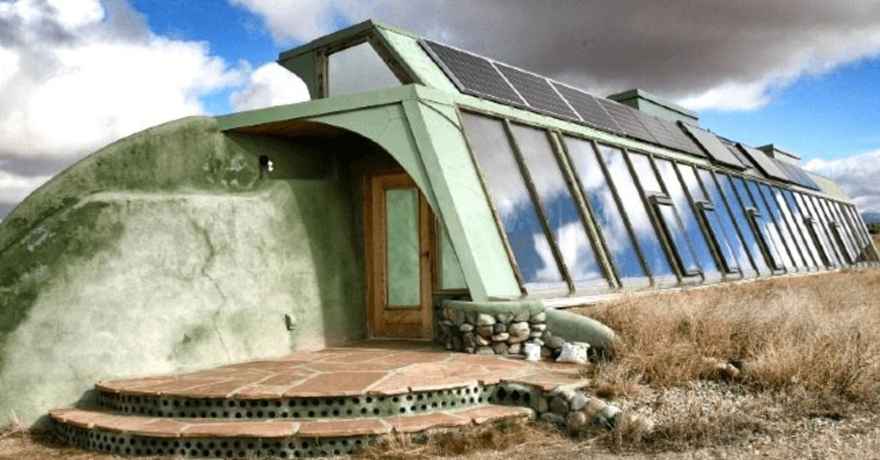Creating Healthy and Sustainable Buildings

“For wholeness — the basis of health — we need nourishment at every level. The complex and dynamic organisation of the physical body underpins our relationship to spatial qualities. Life enhancing qualities around us support our life energies. Colour, harmony, multi-sensory delight support our feeling life, particular moods redressing personal and situational imbalances. … Buildings built upon these principles are buildings to nurture the whole human being.”
Designing and building sustainable buildings and retrofitting the existing building stock are important aspects of creating sustainable settlements. The approach is based on a whole systems design philosophy, the appropriate use of technology and the inclusion of the users of the buildings in the design or re-design process. This echoes Gaia Education’s collaborative whole systems design approach which is the basis of this course. Rather than architects and builders working as contracted service providers, we need to invited these professionals into participatory processes that involve them in training residents and co-designing with them. Such participatory planning and design takes a little longer initially, yet it ensures the future success of eco-developments.
Key features include:
- Conservation — mainly around green building materials;
- Energy — aiming at carbon neutrality;
- Bioclimatic strategies — intelligent design;
- Waste management — recycling solids and water as far as feasible;
- Communications — community involvement as well as smart controls of technologies, broadband services and security.
For low carbon buildings, as a general guideline, 50% of the success can be attributed to architecture, 25% to good and efficient systems and equipment and 25% to the attitude of the occupants. Only if residents understand the energy and water saving features of their houses will they know how to operate them appropriately and will be motivated to do so.
Rather than simply giving a list of green building technologies, in this module will explore different options using the examples of a typical ecovillage or sustainable community or co-housing development of up to fifty houses, with strategies for cold and warm climates. Here is the outline programme for the settlement. You can think of it as the ‘design brief’ that was co-developed by inclusive decision making processes involving all or most of the future residents.
Here is their wish-list:
- A simple shared design theme fitting into the local vernacular
- Relatively small houses, making for economy and small ecological footprint
- Passive solar space & water heating (see energy section)
- Bioarchitecture — cooling with landscaping and roof overhangs for shading and natural ventilation
- Using local materials where possible with low embedded energy
- Carbon neutral settlement in operations, which means no fossil fuels, or at least built to a “Gold Standard” of 4 to 6 kgCO2pa/m2
- Using permaculture as a key design principle within the settlement
- Small scale food production, with protected crop horticulture
- Cooking and supplemental heating using biomass, including district heating systems
- Rainwater collection and grey water irrigation
- Local sewage treatment and treated effluent re-use, including composting toilets
- Composting of organic wastes
- Shared facilities — gardens, common house, outdoor kitchen, wood-fired hot tub and/or sauna, greenhouse, chicken tractors, laundry & bike shed
- Cohousing and land trust ownership model
- Car sharing and biodiesel production
David Pearson, founder of the Ecological Design Association in the UK and co-founder of Gaia International, an innovative group of ecologically responsible and inspired architects, believes that “far from expensive technological dreams, we need a down to earth vision — a future home integrated into a sustainable lifestyle for all of us.” He argues: “Whether old or new, future housing will need to employ life-supporting systems. Materials, and spatial designs that meet the health, conservation and spiritual criteria” (Pearson, 1998, p.57) listed in the ‘Gaia House Charter’.
This is a list of criteria for holistic sustainable building that was drawn up by the members of Gaia International. Many such houses have already been built and many old existing structures have been converted with these principles in mind. These are the beginnings of a complete transformation of the existing building stock to meet the long-term requirements of sustainable and regenerative living.
- Site, orient, and shelter the home to make best and conserving use of renewable resources. Use the sun, wind, and water for all or most of your energy needs and rely less on supplementary non-renewable energy
- Use green materials and products — non-toxic, non-polluting, sustainable, and renewable, produced with low energy and low environmental costs, and biodegradable or easily reused and recycled.
- Design the house to be intelligent in its use of resources and complement natural mechanisms, if necessary with efficient control systems to regulate, heating, cooling, water, airflow and lighting.
- Integrate the house with the local ecosystem, by planting indigenous tree and flower species.
- Compost organic wastes, garden organically, and use natural pest control — no pesticides.
- Recycle greywater and use low-flush or waterless toilets. Collect, store, and use rainwater.
- Design systems to prevent export of pollution to the air, water, and soil.
- Make the home harmonious with its environment — blending in with the community, the building styles, scale and materials around it.
- Participate with others at every scale, using personal ideas and skills of all in order to seek a holistic living design
- Use proportions, forms and shapes that are harmonious, creating beauty and tranquillity.
- Use colours and textures of natural materials and natural dyes, paints, stains to create a personal and therapeutic colour environment.
- Site and design the house to be life enhancing, and increase the wellbeing or vital force chi, of its occupants.
- Connect the home with Gaia and the natural world and the rhythms and cycles of the Earth, its seasons, and its days.
- Make the home a healing environment in which the mind and the spirit can be free and flourish.
- Create a healthy indoor climate by allowing the house to breathe, and use natural materials and processes to regulate temperature, airflow and quality.
- Site the home away from harmful EM [electro-magnetic] radiation from power lines and also away from negative ground radiation. Design to prevent the build-up of static and EMF [electro- magnetic fields] from domestic equipment, and to avoid interference with beneficial cosmic and terrestrial radiation.
- Provide safe and healthy air and water, free from pollutants (radon especially), with good humidity, negative-ion balance, and pleasant fragrance from herbs, materials, and polishes. Use natural airflow and ventilation.
- Create a quiet home, protect and insulate from external and internal noise, and a pleasant, sound- healthy environment.
- Design to allow sunlight and daylight to penetrate, and thus rely less on artificial lighting.

ABOUT THIS ARTICLE
Many of us feel that our current consumer lifestyles are no longer sustainable nor desirable, on a personal to global level and that our ecological systems appear to edge closer and closer towards collapse, but we believe that more sustainable or regenerative ways of living our lives are possible, feasible and viable, but what are these alternative ways of living? In trying to Design for Sustainability we seek to consciously reinvent ecological living from the ground up, honing in on aspects such as sustainable production and consumption, regenerative agriculture and food production, appropriate technologies for water and energy systems, green and sustainable building and construction, and weaving all together through whole systems and regenerative design approaches and methods to achieve one planet living design and development outcomes.
NOTE: Gaia Education’s online course in Design for Sustainability offers you an opportunity to learn practical effective ways to create the change we all seek in your community. The Ecological Design dimension of the course starts on 2nd January 2018 and there are a limited amount of places left for this year, so sign up now.
The material for this dimension was originally compiled by Christopher Mare, one of the founding members of the GEESE (Global Ecovillage Educators for a Sustainable Earth). The Ecological Design contents were revised in 2016 by Gaia Education’s head of innovation and design Daniel Wahl. Some of the material was created with contributions from Ezio Gori, who also mentors the Ecological dimension and the Design Studio of the online course.



0 comments
Leave a comment